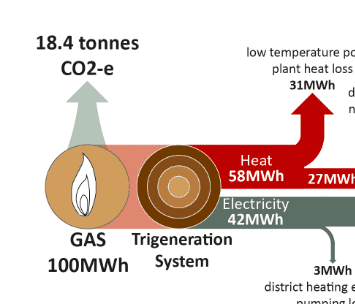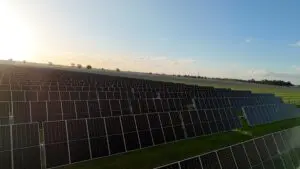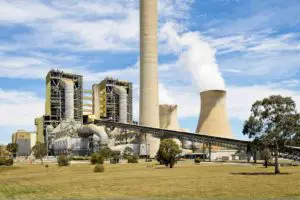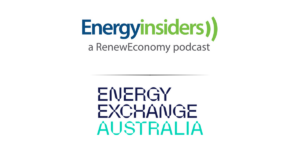Since the industrial revolution, when cities became dirty places, we have been removing pollution from their streets and neighbourhoods.
We’ve seen old central coal plants closed down and replacements built hundreds of kilometres away.
Stricter and stricter vehicle emissions standards have been enacted to reduce local pollution and improve the health, wellbeing and happiness of city dwellers.
So why would you choose to then bring a gas power plant back into the centre of the city, where it will release large quantities of health-damaging nitrogen oxide?
A subsidiary of Origin Energy and the City of Sydney have done a deal to start rolling out trigeneration (“trigen”) gas generators in the most heavily populated urban area of Australia.
Trigen is being touted as the new clean, decentralised system for generating power. You might hear about its fabulous efficiency, or the potential to burn renewable bio-gas in future, but when you remove the spin, it’s just re-packaged fossil gas.
But our concern is not just that it’s not renewable, or the nitrogen oxide gases, among other pollutants, that will damage respiratory health. As it turns out, trigen’s carbon emissions and energy efficiency aren’t that great either.
Comparing apples with apples
The City of Sydney compares its trigen plan to burning coal in existing plants. It actually would have been more accurate to compare it to the grid average, which is lower (because it includes some gas and hydro, in particular).
But that’s not our main point. Its easy to look better than the coal-dominated status quo, but it would have been fairer if they compared it to other possible efficiency upgrades with similar capital expenditure and energy costs.
That way we can also see what the “opportunity cost” is for going with trigen, as compared to the benefits and opportunities of other options we could take.
In our view, the alternative upgrade options to trigen would centre around an energy efficiency program upgrading existing building chillers (airconditioning). The upgraded chillers could be powered by a new, conventional gas-fired power plant out of town, or (preferably) by new renewable electricity generation.
Following is our comparative survey of these two options, which highlight the weaknesses of the trigen case.
How efficient?
The council claims that reciprocating engines burning gas between 7am-10pm will be 42 per cent efficient in creating electricity; and of the remaining waste heat, 25 per cent equivalent of the gas’ original energy will be delivered to buildings in the form of heating and cooling, using an old-fashioned absorption chiller.
This claim adds up to 67 per cent of the total energy that was in the gas to start with being delivered in useful form to residents and businesses.
However, 3 per cent of the electricity generated is used to pump water around the 40km-long hot water network. This would not be necessary in a non-district heating/cooling system, such as our alternative scenario.
A further 6 per cent of the original energy is lost using an absorption chiller for creating chilled water, as these only run with a Co-efficient of Performance (COP) of 0.7; that is, 0.7 times the input energy is delivered.
So despite using 67 per cent of the energy in the gas, the system is only really 58 per cent efficient at delivering energy service to customers.
Today’s average Sydney city building chiller plant has a Co-efficient of Performance (COP) of 2.5 – that is, 2.5 times the energy in the electricity is delivered as pumped heat. Compare this to COP 0.7 for absorption chillers.
Modern chillers are heat pumps: they concentrate the ambient heat. Their energy use is from compressing and pumping to supply or remove heat, not from creating it.
At COP 2.5, current chiller plant is only drawing on 40 per cent of its delivered energy from grid electricity while the other 60 per cent is the renewable, ambient heat it harvests.
So here’s the clincher: delivering 19 per cent of the gas’ energy for heating and cooling (as shown in the City of Sydney report) only displaces that 40 per cent of building heating/cooling which is currently generated by grid electricity; 40 per cent of 19 per cent is 7.5 per cent, which is the equivalent energy needed to run today’s chiller plant and deliver the same heating and cooling as the trigen scenario.
What would a standard alternative look like?
So what if we were to burn the gas in a modern “best performance” combined cycle gas turbine (CCGT) plant outside town instead? This is just “business-as-usual” that is already in use in much of the world, yesterday’s answer to coal’s high carbon emissions.
According to General Electric such a plant would achieve 55 per cent efficiency (55 per cent of the gas energy converted to electrical energy).
According to Marginal Loss Factor data from the Australian Energy Market Operator (AEMO), delivering electricity from a remote generator to a large building in Sydney would lose no more than 5 per cent of the electricity in transmission and distribution.
This means that, including transmission losses, a CCGT plant out of town would be 52.25 per cent efficient at delivering electricity into a city building (95 per cent of 55 per cent).
So at this stage, our alternative is a little less efficient than trigen’s 58 per cent. But we’re not finished yet.
The latest, most efficient heat recovery chillers achieve an impressive COP 6.5 – so we can more than halve the current electricity demand for cooling by going from COP 2.5 to COP 6.5 chiller technology.
This option uses 138 gigawatt hours (GWh) of electricity for heating and cooling. This almost exactly matches the 135GWh that is used just pumping water in the trigen plan.
As a bonus, our chiller upgrade would reduce the peak electricity demand in the city by about half, since most of this demand is from air conditioning. This would reduce energy bills, lowering transmission/distribution loss factors (all of which are higher during peaks), and reduce carbon emissions.
The CCGT option would also give a benefit out-of-hours (10pm-7am every day) when the City’s trigen would be idled due to economic reasons; and during summer peaks, when the old (currently existing) chiller system will be required to run, drawing more power to supplement the trigen system.
Comparing those percentages again
Just 3.5 per cent of the annual energy used for the CCGT gas plant would deliver the same amount of heating and cooling as the City of Sydney’s Tri-gen proposal, if we upgrade the chillers as well.
With the central CCGT plus central chiller-upgrade option we end up with the equivalent of 73 per cent of the energy contained in the fossil gas delivered as useable energy: 52.5 per cent plus the performance multiplier of the new chillers.
This is well ahead of the real end use energy in the City of Sydney’s Trigen option, and even ahead of their claimed efficiency. The extra percentage gain in our scenario is not waste heat from burning gas, but just harvesting renewable heat.
If all these percentages are confusing, the diagram below illustrates the relative quantities of energy used (and wasted) from the different scenarios, all of which deliver the same output in terms of useable energy.
Burning 20% less gas
Our example CCGT option delivers the same amount of electricity, cooling and heating to city buildings as the trigen proposal, with only 80 per cent of the amount of gas burned.
The Sydney trigen proposal will consume 17,000TJ (Terajoules) of gas per year. This is the equivalent of 86 average days of current gas supply from the Moomba gas field.
Moomba is Sydney’s main fossil gas field now, but in the future the supply will increasingly include coal-seam gas. Our calculations exclude the latest damning research on fugitive emissions, ie gas leaks – a significant problem, especially with coal-seam gas, but beyond the scope of this analysis.
With gas use comes high and volatile fuel prices, and increasingly, land degradation. This land impact could be from coal-seam gas production on prime agricultural land, or in the future, by jacking up demand for land-hungry biogas production.
As we move to renewable energy, biofuels will be needed for our industrial economy: steel production and other chemical processes; range-extending motor vehicles; and operating other specialist plant and agricultural machinery. We shouldn’t divert them to jobs that can be done by other means.
Let’s just skip the gas options
The sensible course of action would be to to bypass dirty fossil gas within the city, and upgrade chilling plant instead, taking advantage of renewable ambient heat: the city’s greatest renewable resource.
And then the city should bypass the gas age altogether.
A 100 per cent renewable option to supply the annual electricity demand of the upgraded building chiller plant could be supplied with wind and solar power.
The city could commission a dedicated 330MW wind farm in the region, and 660MW of photovoltaic solar panels for the other half.
The solar panels could be installed in the City of Sydney and two or three of the neighbouring municipalities with just 130,000 5kW rooftop systems. It’s not that much: Australia currently has over 700,000 rooftop solar systems on private residences alone.
We would achieve 1042GWh annually from each of these sources, assuming a fairly common 35% capacity factor for wind, and 18 per cent capacity factor for solar.
Which road shall we take?
100 per cent renewable energy will of course reduce carbon emissions to zero. But renewables come in smaller units. You don’t have to build the whole replacement all at once.
What if we built just enough renewables to reduce emissions by the same amount as the trigen plan? It turns out we would have to supply just 39 per cent of the energy from renewables, if we also go with the building chiller upgrade.
That way Sydney will be well on the road to 100 per cent renewables and genuine energy efficiency, instead of a costly and dirty detour through gaslands. It’s Clover Moore’s choice now on which road she wants to steer Sydney down.
Beyond Zero Emissions will be releasing a special Sydney Buildings plan in July to coincide with the release of the Zero Carbon Australia Buildings plan.









